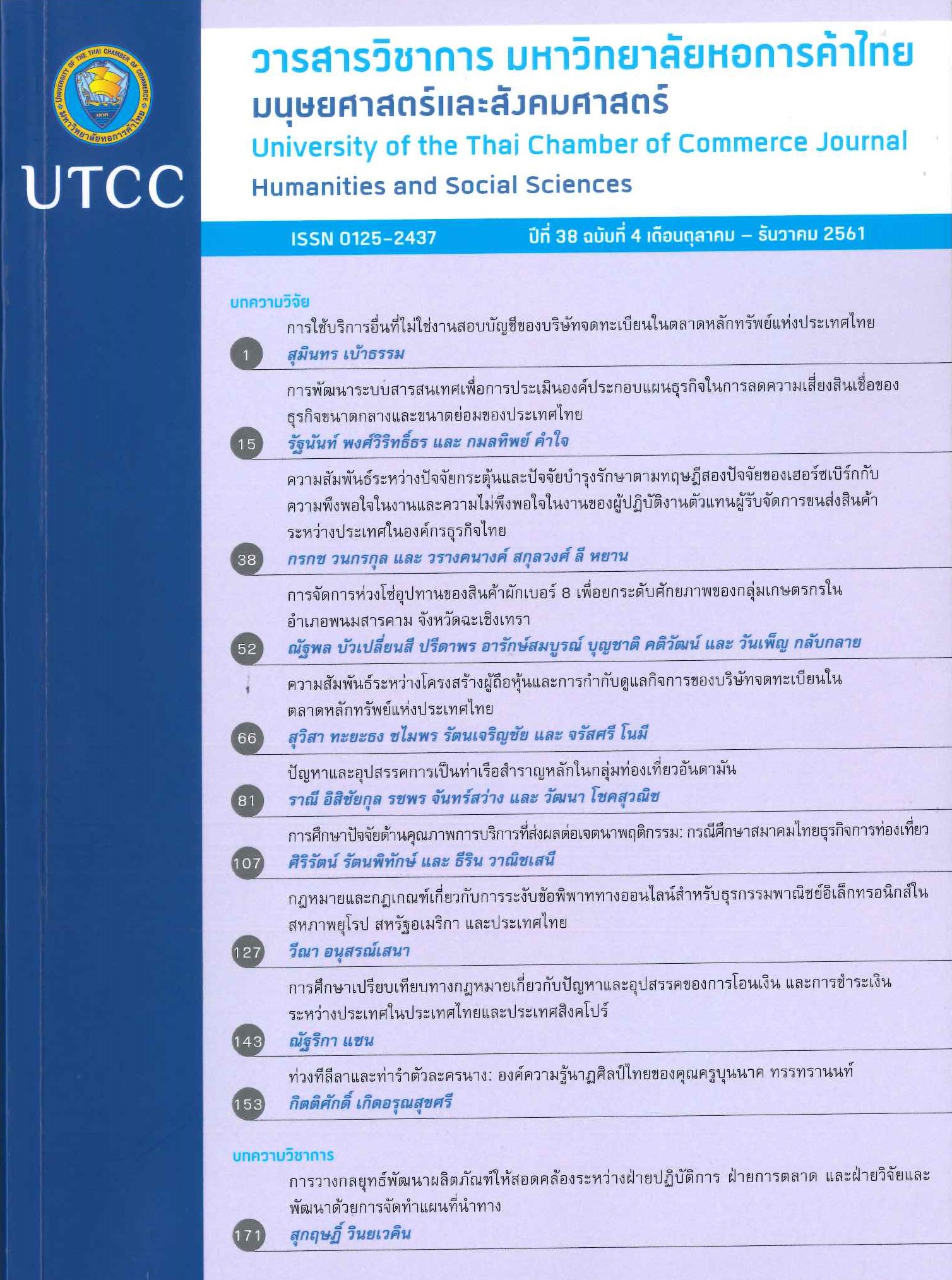The Impact of Service Quality on Behavioural Intention: A Case Study of The Association of Thai Travel Agent (ATTA)
Main Article Content
Abstract
The objectives of this research are to study the impact of service quality on two behavioural intentions. The researchers use the Association of Thai Travel Agents (ATTA) as a research subject and questionnaire as a method for collecting data. The questionnaire consists of three parts: personal information, service quality, and behavioural intentions. The structural equation model (SEM) was used to analysed the data. A conceptual model is adapted from the works of Parasuraman, Zeithaml, and Berry (1988); Park, MacInnis, Priester, Eisingerich, and Lacobucci (2010); Zeithaml, Berry, and Parasuraman (1996). Results indicate that interaction quality and environment quality have an impact on service quality of ATTA. Increasing in service quality boosts the ATTA members’ loyalty, and reduces willingness to resign from ATTA. Both loyalty and willingness to resign lead to attachment to ATTA. However, the evidence shows that there are two facets of attachment: positive attachment and negative attachment. It can be seen from the results that loyalty have an impact on attachment which demonstrates the perspective of positive attachment. However,
there is a significant relationship between willingness to resign and attachment. This means the willingness to resign which is a negative behavioural intention can create the attachment between ATTA and its members.
Article Details
ลิขสิทธิ์ของบทความ
ผลงานที่ได้รับการตีพิมพ์ถือเป็นลิขสิทธิ์ของมหาวิทยาลัยหอการค้าไทย ห้ามมิให้นำเนื้อหา ทัศนะ หรือข้อคิดเห็นใด ๆ ของผลงานไปทำซ้ำ ดัดแปลง หรือเผยแพร่ ไม่ว่าทั้งหมดหรือบางส่วนโดยไม่ได้รับอนุญาตเป็นลายลักษณ์อักษรจากมหาวิทยาลัยหอการค้าไทยก่อน
References
Amine, A. (1998). Consumers' true brand loyalty: The central role of commitment. Journal of Strategic Marketing, 6(4), 305-319.
Bitner, M. J., Booms, B. H., & Mohr, L. A. (1994). Critical service encounters: The employee's viewpoint. The Journal of Marketing, 58(4), 95-106.
Brady, M. K., & Cronin, J. J., Jr. (2001). Some new thoughts on conceptualizing perceived service quality: A hierarchical approach. Journal of Marketing, 65(3), 34-49.
Byrne, B. M. (2016). Structural equation modeling with AMOS: Basic concepts, applications, and programming (3rd ed.). Oxon, UK: Routledge.
Creswell, J. W. (1994). Research design: Qualitative and quantitative approaches. Thousand Oaks, CA: Sage.
Denzin, N. K., & Lincoln, Y. S. (Eds.). (2011). The Sage handbook of qualitative research (3rd ed.). Thousand Oaks, CA: Sage.
Grönroos, C. (1984). A service quality model and its marketing implications. European Journal of marketing, 18(4), 36-44.
Harris, M. (1998). Doing it their way: Organizational challenges for voluntary associations. Nonprofit and Voluntary Sector Quarterly, 27(2), 144-158.
Jackson, D. L. (2003). Revisiting sample size and number of parameter estimates: Some support for the N: q hypothesis. Structural Equation Modeling, 10(1), 128-141.
Kline, R. B., & Santor, D. A. (1999). Principles and practice of structural equation modelling. Canadian Psychology, 40(4), 381-383.
Nunnally, J. C., & Bernstein, I. H. (1978). Psychometric theory. New York, NY: McGraw-Hill.
Parasuraman, A., Zeithaml, V. A., & Berry, L. L. (1988). SERVQUAL. Journal of Retailing, 64(1), 12-40.
Park, C. W., MacInnis, D. J., & Priester, J. R. (2006). Beyond attitudes: Attachment and consumer behavior. Seoul National Journal, 12(2), 3-36.
Park, C. W., MacInnis, D. J., Priester, J., Eisingerich, A. B., & Lacobucci, D. (2010). Brand attachment and brand attitude strength: Conceptual and empirical differentiation of two critical brand equity drivers. Journal of Marketing, 74(6), 1-17.
Smith, J. A. (Ed.). (2015). Qualitative psychology: A practical guide to research methods. Thousand Oaks, CA: Sage.
Stutely, R. (2014). Numbers guide: The essentials of business numeracy (6th ed.). Princeton, NJ: Bloomberg Press.
Zeithaml, V. A., Berry, L. L., & Parasuraman, A. (1996). The behavioral consequences of service quality. The Journal of Marketing, 60(2), 31-46.


